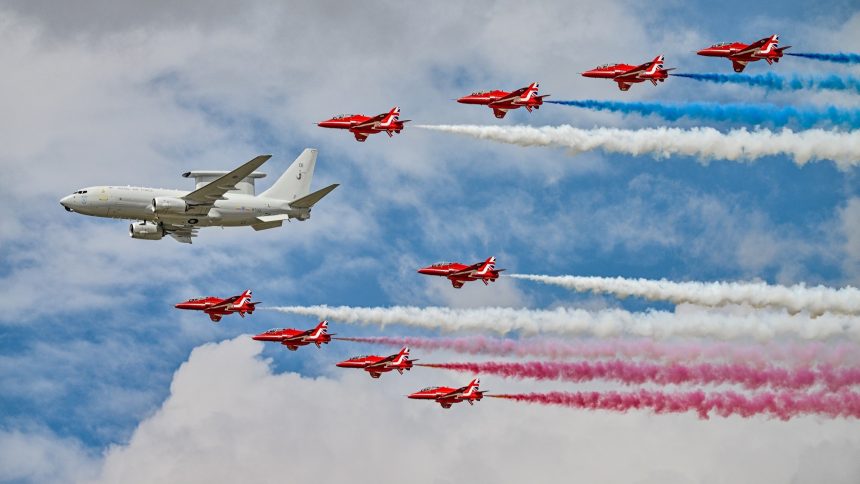The Royal International Air Tattoo delighted crowds with an incredible number of modern aircraft, including for the first time the RAF E-7 Wedgetail AEW1.
The latest in the series of Airborne Early Warning and Control (AEW&C) aircraft for the Royal Air Force, the E-7 Wedgetail AEW1 took to the skies over RIAT on Saturday for its public debut. Flanked by the Red Arrows display team, the aircraft roared into Fairford’s skies, before performing a touch and go landing for the watching crowds. The RAF’s sole Wedgetail then returned to Birmingham Airport where test and evaluation trials continue.
Programme Director for the E-7 Programme, Group Captain Osselton, stated:
“The Wedgetail appearance at RIAT not only reinforces the hard work and collaboration of all those contributing to the project but also reflects the importance of delivering the next generation of airborne surveillance and control capabilities to support the RAF’s operational effectiveness in the years to come.”
RAF’s E-7 Wedgetail debut at RIAT pic.twitter.com/exyErLojk1
— Brian Everstine (@beverstine) July 19, 2025
The Wedgetail has been the focus of significant media attention in recent weeks, owing to industry delays pushing delivery into 2026, significant changes to American policy towards manned AEW&C aircraft, and the announcement from the British Government that more Wedgetails are likely to be procured in the near future.
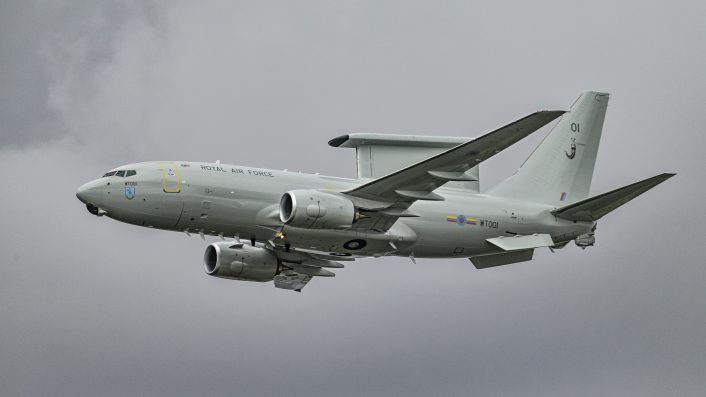
This would likely increase the fleet from a planned order of three to five, going along with what the RAF recommends for a minimum viable capability. The RAF expects to operate these aircraft from RAF Lossiemouth alongside the fleet of nine Poseidon MRA1 already based there, as the two aircraft share the same base aeroplane.
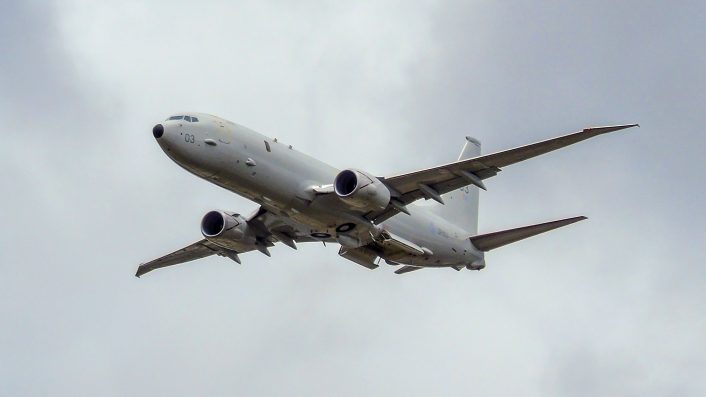
The Wedgetail’s unveiling is the centrepiece to this year’s RIAT theme of ‘Eyes in the Sky’, celebrating the role that aviation plays in surveillance missions of many different types. Aircraft attending, both civilian and military, represented the key areas of airborne surveillance, including AEW&C, maritime patrol, search and rescue, reconnaissance and signals intelligence.
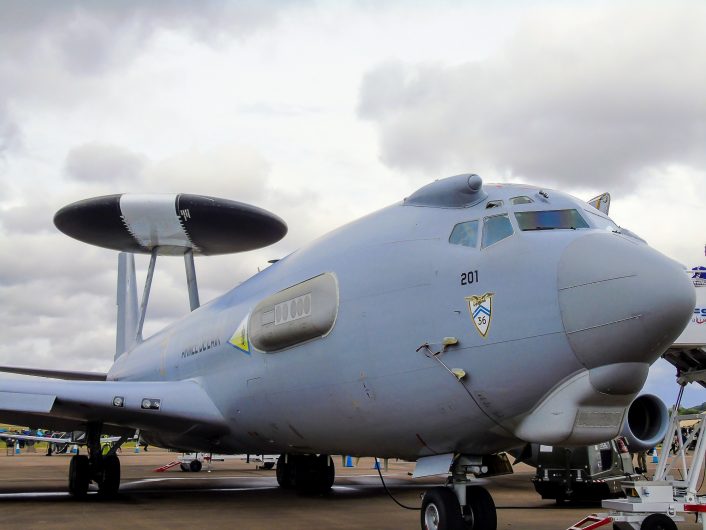
Under this theme, the French Armée de l’Air et de l’Eespace sent an E-3F Sentry AWACS for the static display, representing the last 30 years of western AEW&C aircraft. The Sentry has been at the core of western air campaigns since the 1991 Gulf War, with other variants flying for the UK, USA and NATO, over its long service life.
The French E-3F had recently been deployed to monitor Ukrainian air space, following the brief pause in American intelligence sharing that took place earlier in the year. It was revealed recently at the Paris Air Show that the E-3F will be replaced by the Saab GlobalEye, an aircraft of growing popularity worldwide.
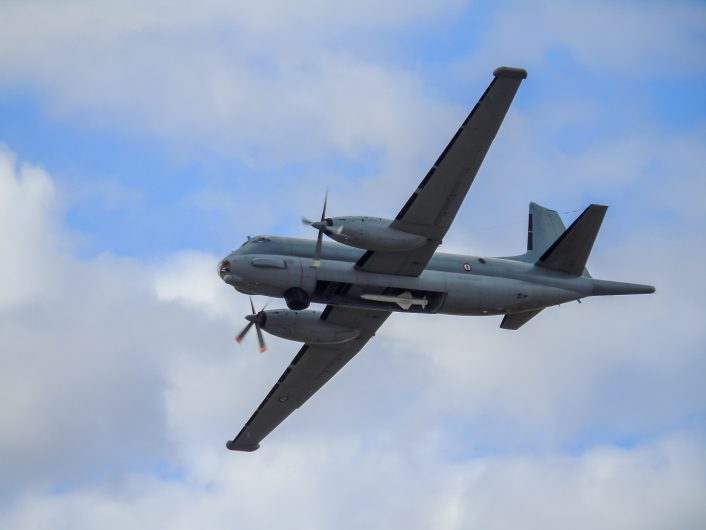
Alongside the air force, the Marine Nationale sent a rather rare aeroplane, the Bréguet Atlantique 2 (ATL2) maritime patrol aircraft, which put on a wonderful air display. The aircraft is used to protect the navy’s SSBN nuclear submarines from being tracked by adversarial submarines and shipping. To this end the aircraft comes equipped with a large bomb bay for carrying both sonar buoys and Exocet anti-ship missiles.
During the display the aircraft opened the bay doors to reveal a dummy Exocet to the crowd, before it continued its low altitude passes along the flightline. Expected to stay in service until at least 2035, the ATL2 was my personal highlight of Sunday’s displays owing to its slow speed making photography much easier.
USAF Surprises
RIAT 2025 included a surprising assortment of aircraft from the United States Air Force, with aircraft arriving from RAF Lakenheath, RAF Mildenhall and the continental United States. The Americans always bring a number of great aircraft to the RIAT flightline with a single F-15E, two F-35As and a variety of transport aircraft from the country’s UK bases. These were also joined by three beautiful rarities that made this event a must visit.
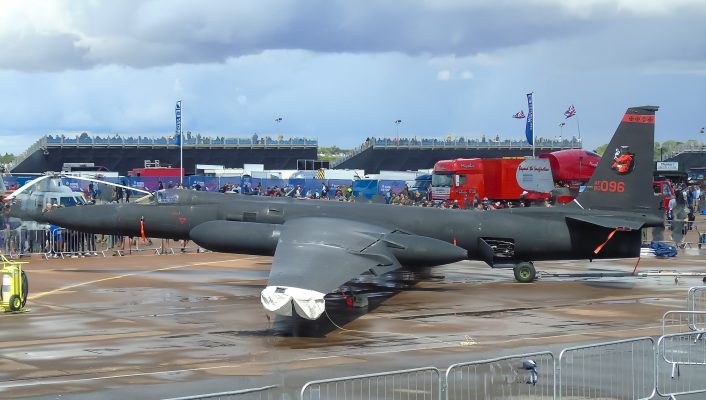
Displaying to the crowds with the unique roar of its engine was the Lockheed U-2S, also known as the Dragon Lady. The Dragon Lady may not have been named for the sound that its engine makes on takeoff, but it is a fitting moniker given the almost Vulcan-like noise it is capable of producing. Originally designed for high altitude photo reconnaissance missions overflying the Soviet Union (USSR), the aircraft proved to be pretty handy during the low level displays over Fairford. Credit to the pilot as this straight winged glider-like aircraft is reportedly a tricky customer to fly at the best of times.
🇺🇸 U-2 out at #RIAT25 today.
Living near to Fairford I have posted a lot of videos of the U-2 over the years including the practice for RIAT a few weeks ago.
Would recognise that sound now anywhere! 🐲 pic.twitter.com/upOC6Uq2Yc
— Planes Out The Window ✈️ (@window_planes) July 19, 2025
Taking to the skies for the first time in 1955, the U-2 will be 70 years old this year, making it one of the oldest aircraft around the world still in service. Two are based at RAF Fairford providing the United States Air Force with expeditionary air surveillance capabilities which can be deployed globally.
Landing mandates the deployment of a chase car with another U-2 pilot in the passenger seat giving indications to the pilot of the descending aircraft. The chase car radio operator calls out the aircraft’s height above the ground so that the pilot can induce a stall at the correct moment and safely land the aircraft on the ground. These manoeuvres would be very difficult without the chase car, owing to the limited view that pilots have from their cockpits. The end of the air display gave us a great view of the chase car following the Dragon Lady down the runway, which was a fantastic opportunity to witness.
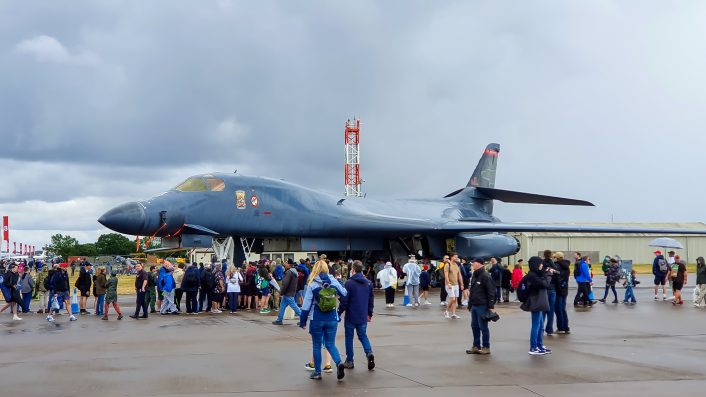
Joining the U-2S on the static was the Rockwell B-1B Lancer, the USAF’s premier supersonic bomber. It is an imposing figure on the flight line, attracting a lot of attention from onlookers on the ground; the RAF hasn’t had a similar capability since the 1980s.
Capable of carrying 75,000 pounds of payload to a target, the Lancer had formerly been a part of the US’ nuclear triad, however these capabilities were removed following the end of the Cold War. Instead, these bombers deploy in the conventional bombing role, operating during most USAF deployments over the last 30 years. The Lancer is additionally deployed in show of force missions, where the sight of an American strategic bomber near a nation’s border acts as a stern warning to avoid unnecessary conflict with the United States and its allies.

My absolute favourite American aircraft to appear at RIAT was the behemoth of a transport plane known as the C-5M Super Galaxy. It is an absolute monster in terms of its size and payload capacity, with it capable of carrying up to six entire AH-64 Apache Gunships in a single flight.
The Galaxy represents the sheer scale of American logistical capabilities, with the aircraft being integral to America’s global military presence. This visualisation of the American logistics chain is an impressive sight at the best of times, but the number of people that could fit into the cargo bay all at once was an awe-inspiring image. Truly a highlight of the weekend.
Lockheed C-5M Super Fred into RIAT 2025 😍 The Royal International Air Tattoo #RIAT2025 pic.twitter.com/qBqvjtz6Yf
— Abbasi (@MohammedAbbasi) July 16, 2025
Visitors From Overseas
This weekend saw visits from some noticeable overseas participants, bringing with them a number of rare and highly decorated aircraft. The Egyptian Air Force is a first time participant to RIAT, now the 59th participant nation to take part in the aviation celebration.
They brought with them a very rare AN-74T Coaler transport aircraft, originally designed by Antonov in the USSR, now Ukraine, as a Short Take off and Landing (STOL) transporter. It is designed to move cargo and passengers to unprepared strips, too short for traditional aircraft, and was originally intended for cold weather operations with the option of fitting of skis.
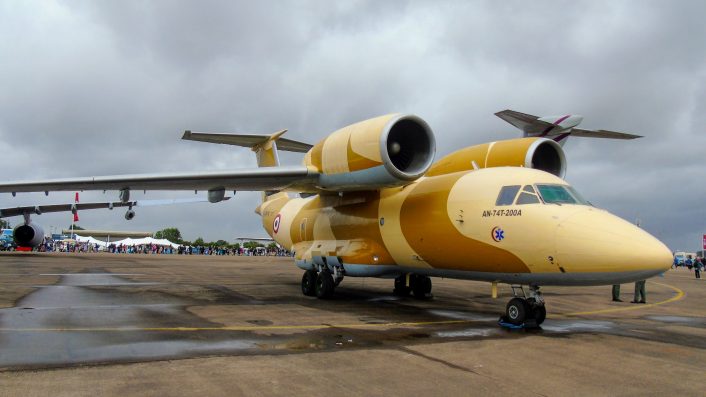
The Egyptian Air Force currently operates three aircraft and is one of only three military operators worldwide, including both Iran and Turkmenistan. This makes it an extremely unique aircraft to grace Fairford.
🇵🇰 JF-17 Thunder Wins “Spirit of the Meet” at RIAT 2025! 🇵🇰
PAF’s JF-17 has been awarded the prestigious Spirit of the Meet Trophy for its striking livery and the incredible journey from Pakistan, made possible through non-stop Air-to-Air Refueling (AAR). pic.twitter.com/s15vVwfcJF
— Tipu Creativity (@Tipu_Creativity) July 18, 2025
The Pakistani Air Force has made a significant contribution to RIAT, bringing with them a number of exciting aircraft. Making its RIAT debut is a pair of JF-17C Thunder multirole fighters, jointly developed by Pakistan and China. This aircraft warranted its own article due to its involvement in a recent aerial skirmish with India and its winning of a RIAT ‘Spirit of the Meet’ award, which can be read about here. The JF-17 is one of very few modern and effective 4th generation multirole aircraft, making its visit to Fairford one of keen interest for fans of aviation.
#PakistanAirForce C-130 Hercules wins the Concours d’Elegance Trophy at #RIAT2025 in the United Kingdom (UK)#Pakistan #PAF #RIAT #ISPR pic.twitter.com/IhoXKDOmoi
— Pakistan Armed Forces News 🇵🇰 (@PakistanFauj) July 19, 2025
For those who remember the Covid times and the unfortunate cancellation of the 2020 and 2021 air shows, the JF-17 was shown, in a limited fashion, in videos made by the PAF for the Virtual Air Tattoo that took place in RIAT’s stead. RIAT organisers the Royal Air Force Charitable Trust arranged for video recordings to be made from a variety of air forces worldwide to demonstrate aircraft that they would like to come to Fairford when Covid restrictions were lifted. Five years later, their promise has now been fulfilled, and boy was it worth it.
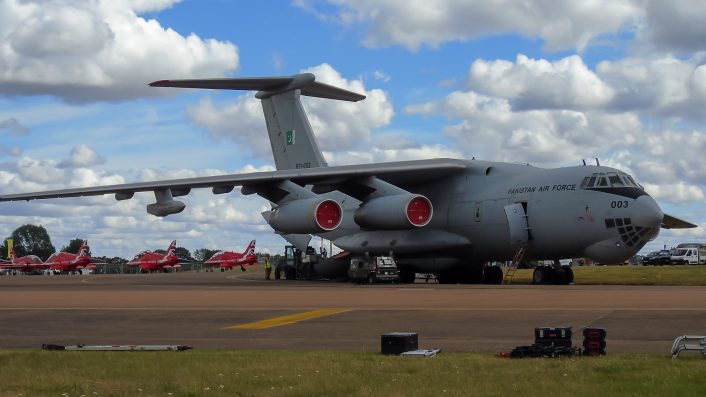
The PAF also sent two transport aircraft, an Ilyushin Il-78 Midas aerial refueling tanker and a specially decorated Lockheed C-130E Hercules. The Il-78 was a surprise to many as it was brought in to support the deployment of the two JF-17 fighters halfway around the world.
Designed as the USSR’s first dedicated air-to-air tanker, the Il-78’s used by Pakistan were bought from Ukraine and refurbished, becoming the sole tanker aircraft used by the PAF. The Midas can refuel three aircraft at once utilising the probe and drogue method, with pods in place on each wing and a single pod under the fuselage. Interestingly the Indian Air Force also operates the Il-78, with these aircraft bought from the Russian Federation.
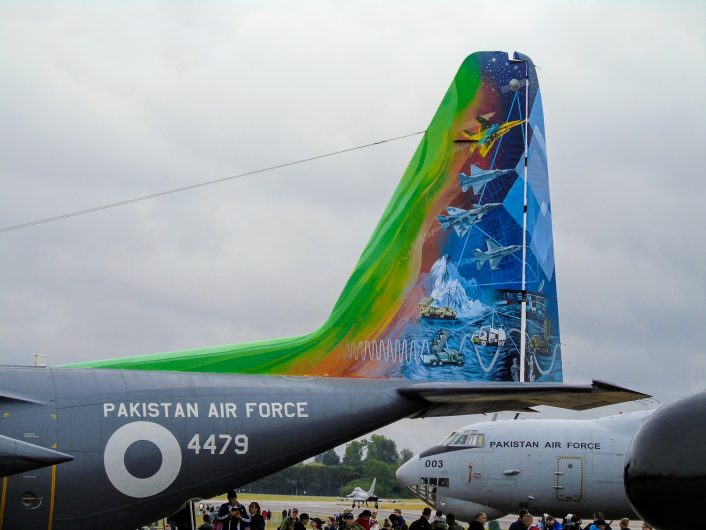
The C-130E sent by Pakistan had an incredible paint scheme emblazoned with the image of an eagle on the front fuselage near the cockpit, and a decorated tail art depicting current and future PAF fighters alongside other parts of the network that Pakistan uses to coordinate air defence. It was done celebrating the ‘Eyes in the Sky’ theme and deservingly it won a prestigious RIAT award as a result.
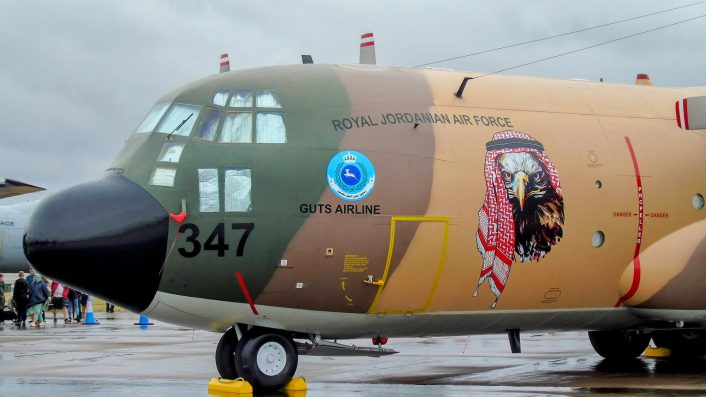
Alongside the newcomers to RIAT, this year saw the return of the Royal Jordanian Air Force, a stalwart of RIAT air displays. They once again sent their Royal Jordanian Falcons aerobatics team to take part in the air displays across the weekend flying the Extra 330LX aircraft. Interestingly, the aircraft are owned by Royal Jordanian Airlines, whilst the pilots of the four aircraft are RJAF officers.
They were supported at Fairford by a well decorated C-130H named ‘Guts Airline’ which is a common occurrence at RIAT. This time it sported the striking image of a Falcon wearing a shemagh, highlighting its role as a Royal Jordanian Falcons support aircraft, which I thought looked extremely cool. The RJAF is a firm friend of the air tattoo, and I look forward to seeing what they bring next year.
Portuguese Merlin #RIAT2025 pic.twitter.com/MoielhgY9Y
— Adventures of an Aviation Nut (@Aircraft_Nutter) July 22, 2025
Air Displays Galore
The air displays at RIAT are always a highlight, and this year was no exception. A trio of Typhoons from the RAF, the Spanish Air Force and the Italian Air Force all proved the sheer brilliance of this fighter in its prime. Joining them were displays from F-16s operated by the Polish Air Force and the Royal Danish Air Force, with the latter performing for the last time at RIAT. The Danish F-16, painted in a fantastic special scheme, made its last air display on Sunday, finishing its performance with a water cannon salute on the runway. Denmark’s last F-16s will be heading on for a second life with the Ukrainian Air Force whilst Denmark re-equips with F-35As.
The Danish F-16 adding a pop of colour to a grey sky on Friday @airtattoo pic.twitter.com/1INEJKtbKH
— Caroline Haycock (@Caz801) July 22, 2025
The Red Arrows were joined by the Frecce Tricolori, the Royal Jordanian Falcons and the Royal Navy’s Black Cats as the four main display teams of the RIAT weekend. The Red Arrows stunned as usual, with high-speed close proximity passes alongside their larger nine-ship formations. They also made history performing their displays using sustainable aviation fuel for the first time, which can be read about here. This follows the RAF Typhoon display aircraft which performed on sustainable aviation fuel at RIAT 2024.
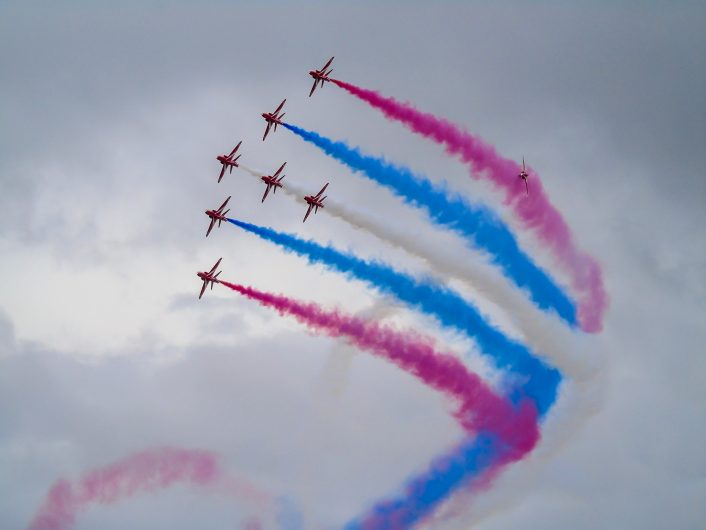
Red Arrows having a bit of a whoosh at #RIAT2025 on Friday. I happened to be standing in a very favourable position :) pic.twitter.com/ywLFHbh1sV
— Jo Brodie (@JoBrodie) July 19, 2025
The Frecce Tricolori took off with an extremely colourful display, firing out the colours of the Italian national flag in their jet exhausts, looking spectacular. The Frecce Tricolori are celebrating their 65th anniversary display season this year, with this being one of their last performances with the Aermacchi MB-339 trainer aircraft. They will soon be transferring to the more modern Leonardo T-346 Master advanced jet trainer.
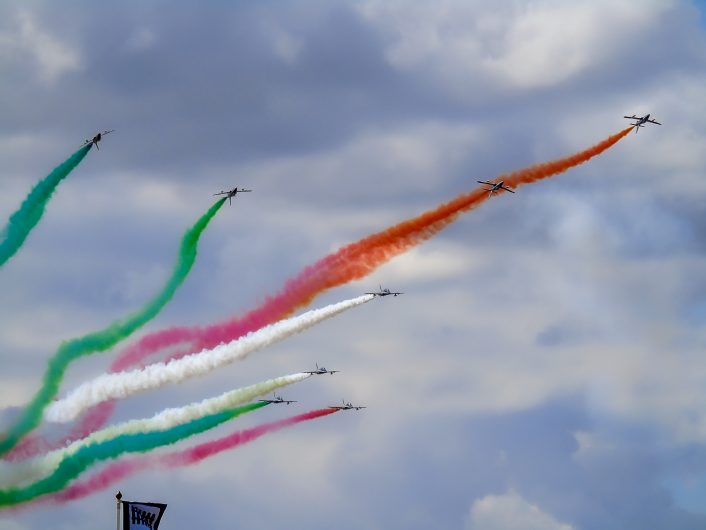
The Italian Airforce at #RIAT2025. pic.twitter.com/jiIFqnTXnL
— A-129 Mangusta (@NichoConcu) July 20, 2025
Speaking of the Master, the Italian Air Force sent two examples to RIAT to take part in the air displays, with one flying solo and the other partaking in a duet with the world’s only flying Fiat G.91R. Designed to fulfil NATO’s requirement for a lightweight strike fighter following the Korean War, the G.91 won the competition and went on to serve into the 1990s.
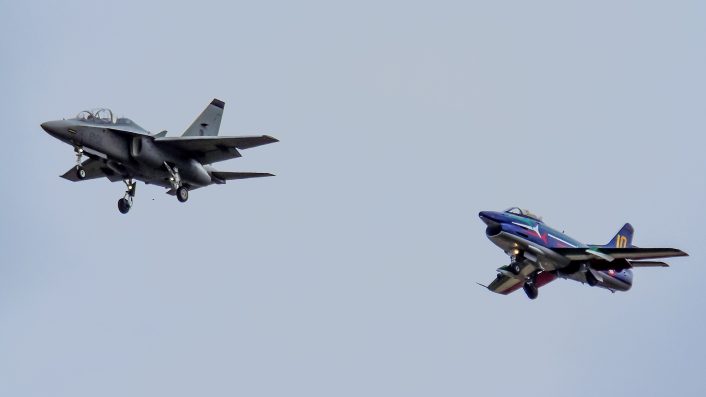
The G.91 was the second aircraft type for the Frecce Tricolori display team, being preceded by the North American F-86 Sabre. This display by the Master and the Fiat was a delight, showcasing both the past and the future of the Frecce Tricolori in the same formation. It was a fantastic highlight to this year’s show.
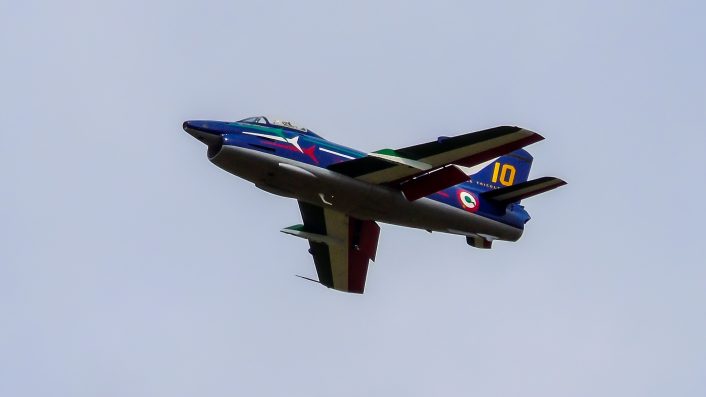
One of the final displays of the show was a performance from the Battle of Britain Memorial Flight, featuring a Supermarine Spitfire and Hawker Hurricane and the UK’s sole flying Avro Lancaster bomber. The Lancaster and the BBMF have been a constant performer at RIAT, and it is only fitting that the show ended with a trio of aircraft with such long standing historical significance.
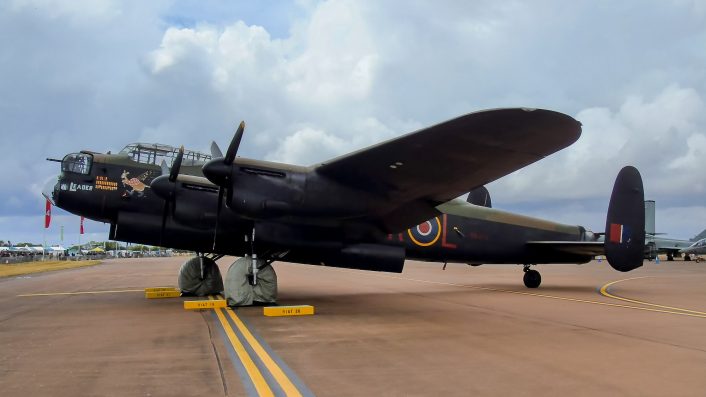
It’s been a fantastic day here at @airtattoo, and we’ve just had today’s Lancaster, Spitfire and Hurricane display 😍✈️
We will be back again tomorrow with another display, and on the ground within the RAF Experience Zone and at the Heritage Corner! #RIAT2025 pic.twitter.com/vtJ4kXFX1x
— RAF BBMF (@RAFBBMF) July 19, 2025
Fourth Generation Fighters
Fourth generation fighters are one of the biggest appeals that RIAT has for its many many fans, with hundreds of thousands of people queuing up for hours just to see these aircraft in person. Here we’ll discuss some of these aircraft and the nations they come from, highlighting the internationalism at the core of RIAT.
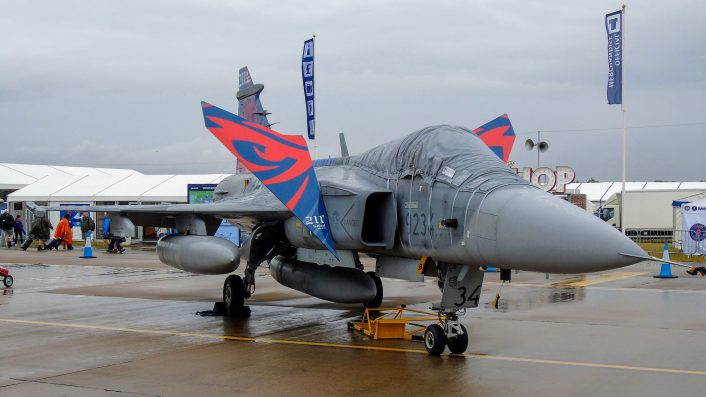
The Czech Air Force made another appearance at Fairford this year with its JAS-39C Gripen, although it was not able to perform due to an injury sustained by the pilot in the week prior to the air show. This aircraft came from 211 Tacticka Letka (211th Tactical Squadron) which is based at Caslav Air Base in Czechia.
Despite the unavailability of the air display, it was great to see such a fantastic looking aircraft up close on the static in a great special scheme. The Czech Gripen is currently set to retire in 2027 although there are ongoing discussions about keeping them in service until the arrival of the F-35.
Instead of the C variant, the crowd was able to see the latest JAS-39E Gripen flown by Saab in the air display. The Gripen E is to be flown by the Swedish, Brazilian, Thai, Colombian and now the Peruvian Air Forces.
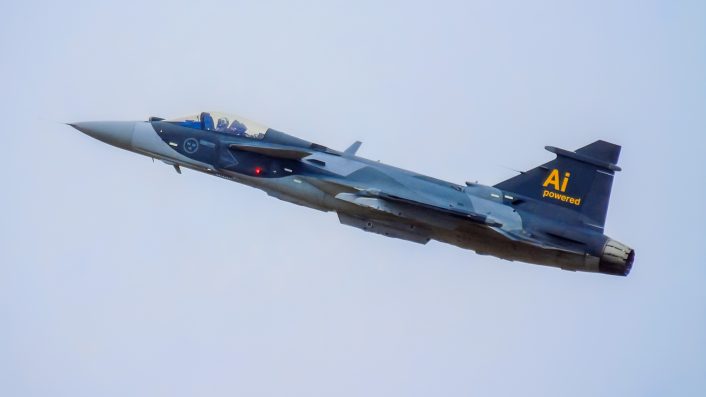
The Polish Air Force and the Belgian Air Force both brought with them F-16s for the static display. Poland still relies on a decent number of former Warsaw Pact aircraft, such as the Mig-29 Fulcrum and the Su-22 Fritter, alongside its fleet of more modern F-16Cs. However, these aircraft are on their way out, replaced by newer FA-50 light fighters from South Korea and the F-35 Lightning II.
Many of Poland’s Mig-29s have already been sent to Ukraine and it is likely that the rest of the fleet will follow when Poland receives more F-35s to replace them. Similarly, Belgium is adopting the F-35 with its F-16s also earmarked for Ukraine, alongside those flown by the Danes.
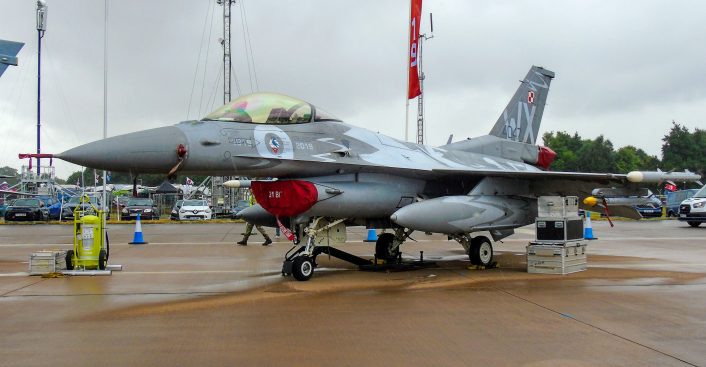
Last year saw the 50th anniversary of the F-16, and a large number of F-16s from all over the world were brought to RIAT for one of the last great meets of the aircraft. The F-16 Fighting Falcon is one of the most iconic fighter jets of all time and it was great to see these two on the static display.
RIAT 2025 🇬🇧 331 ΜΟΙΡΑ «THISEAS»
Hellenic Airforce 🇬🇷 #Mirage2000_5 #Dash_5 pic.twitter.com/H4kzSkKF0r
— AegeanDeltas331® (@AegeanDeltas331) July 19, 2025
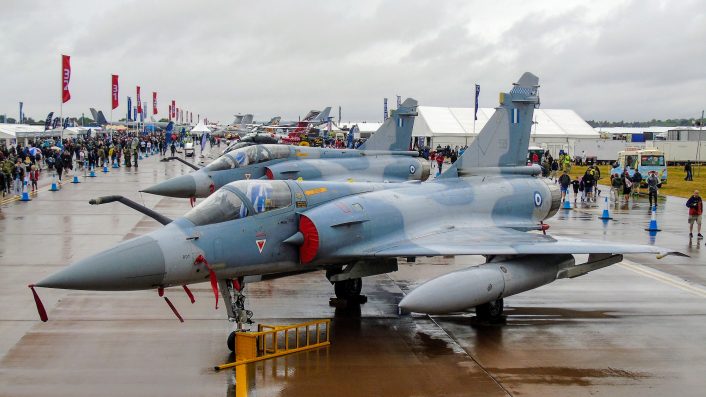
Alongside the Gripens and the F-16s, the Hellenic Air Force sent a pair of Dassault Mirage 2000-5 aircraft for the static display. These aircraft have been flown by Greece since the 1980s, with the modernised versions finishing their deliveries in 2007.
They are still extremely capable platforms, only surpassed by the Rafale, which Greece is also buying alongside an order of American F-35s. These aircraft are flown by 331 Mira ‘Thiseas’ operating traditionally over the Aegean Sea.
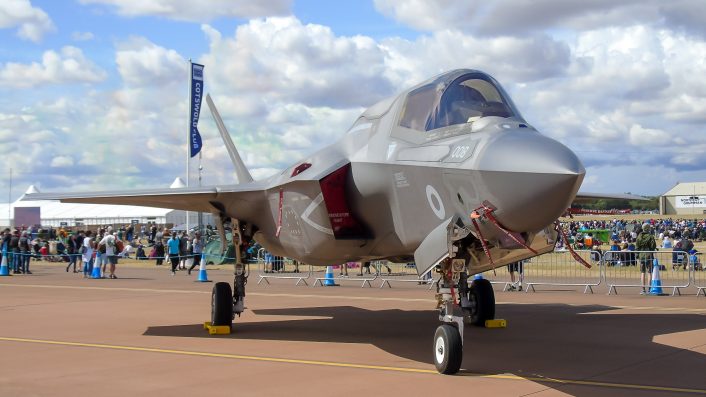
Overall, RIAT 2025 was a fantastic show with more aircraft and air forces taking part than can be mentioned in just this article. Whilst these are just some of the highlights of the weekend there were many more to choose from. RIAT remains one of the biggest and best airshows around the world and it is a fantastic opportunity for those that are able to visit.
RIAT is about more than just the aircraft, it is a symbol of the united joy that aviation brings each participant whether in the crowd or in the sky. Every aircraft that is sent to the UK to take part is a symbol of friendship between nations and peoples that is formed by this shared feeling. It is this that makes the Air Tattoo as special as it is.
Roll on 2026.
That’s a wrap on @airtattoo 2025, the weekend has flown by – see you next year 👋
What were your highlights?#RIAT25 #RIAT pic.twitter.com/LJg9SOSSpb
— Royal Air Force (@RoyalAirForce) July 20, 2025

